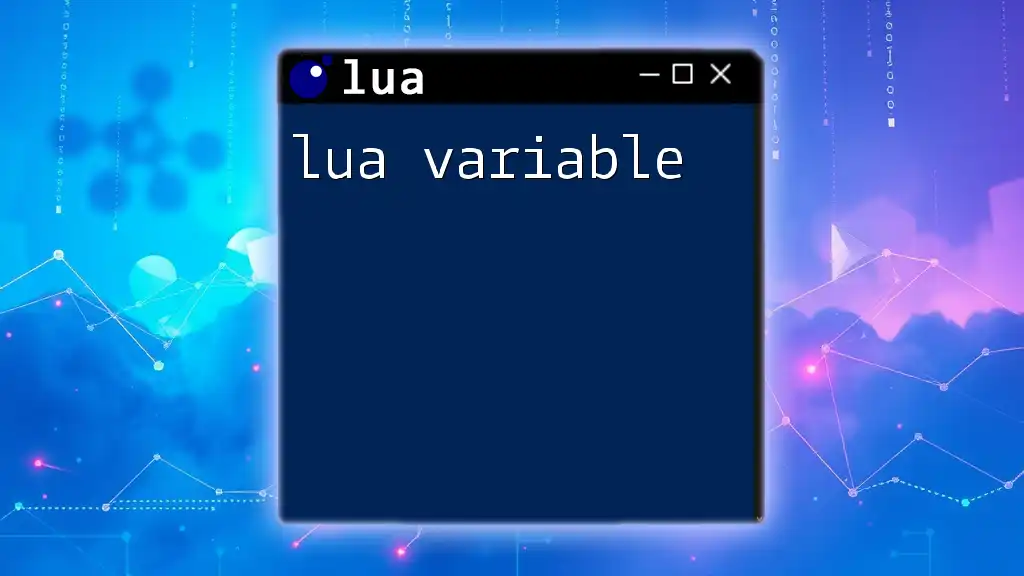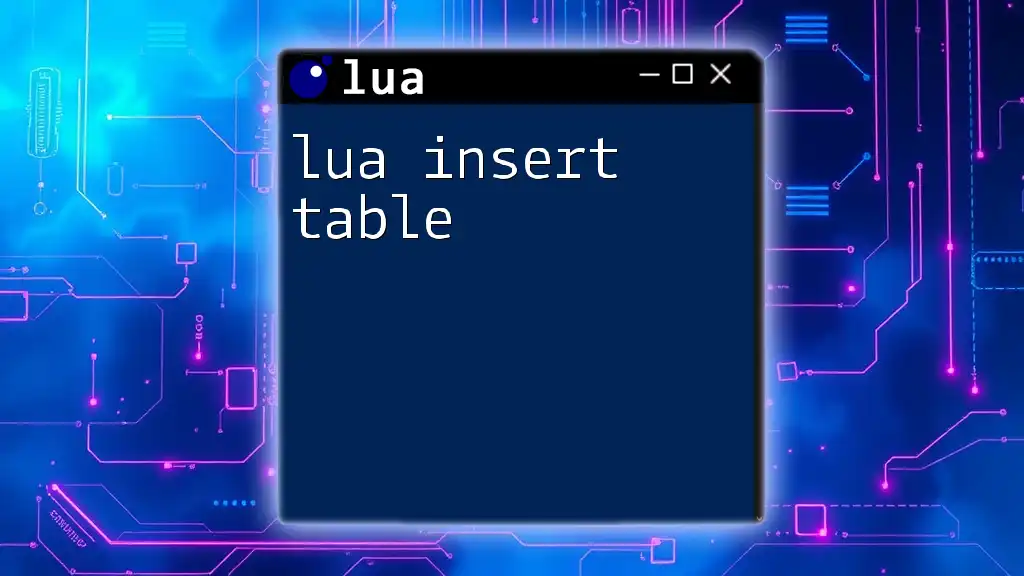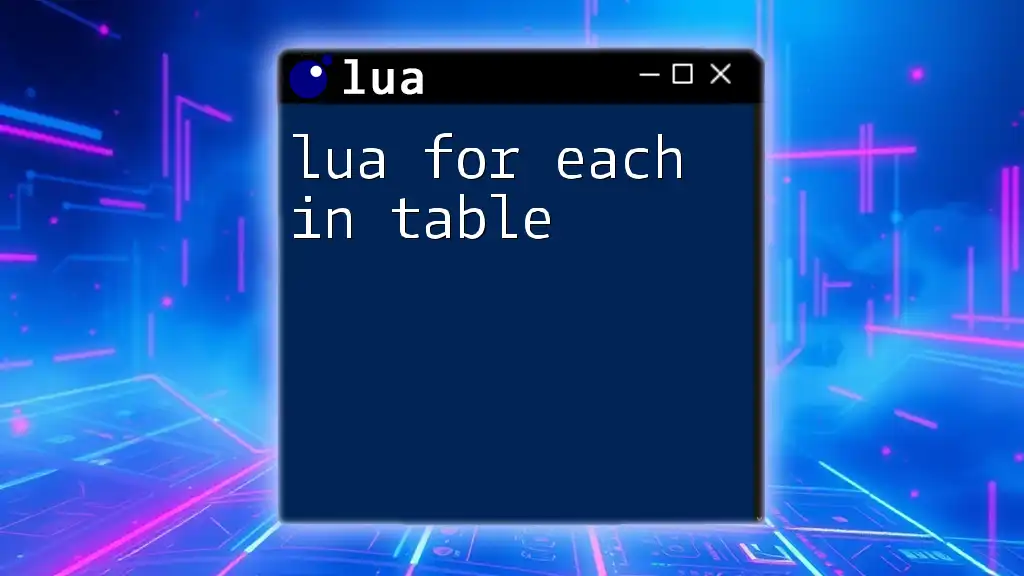The `for in` loop in Lua allows you to iterate over elements in a table, accessing both keys and values seamlessly.
Here's an example:
local fruits = {apple = "red", banana = "yellow", grape = "purple"}
for key, value in pairs(fruits) do
print(key .. " is " .. value)
end
Understanding Tables in Lua
What Are Tables?
In Lua, tables are the primary data structure and can hold different types of values, including numbers, strings, functions, and even other tables. Unlike arrays in other programming languages that can only store elements of the same type, Lua tables are highly flexible and allow you to create mixed data structures.
Tables can be thought of as dictionaries or associative arrays, where each element is stored as a key-value pair. This versatility makes tables essential for Lua programming, especially when dealing with complex data structures in applications.
Types of Tables
-
Array-like tables: These tables use numeric indices to store values. They are often iterated using simple loops.
-
Dictionary-like tables: These tables store data in key-value pairs, allowing for efficient lookups and storage of related data. They are incredibly useful for representing complex relationships.

The Basics of Looping in Lua
What Is a Loop in Programming?
Loops are fundamental in programming as they allow for the execution of a block of code multiple times. In Lua, various types of loops can be utilized, including the `for`, `while`, and `repeat` loops. However, one of the most powerful features of Lua's looping capabilities is the `for in` loop, particularly when combined with tables.

The `for in` Loop in Lua
Introduction to the `for in` Loop
The `for in` loop provides a simple way to iterate over items in a table. Instead of using traditional indexing methods, this loop allows you to access both keys and values directly, making your code cleaner and more intuitive.
Syntax Breakdown
The general syntax of the `for in` loop in Lua is as follows:
for key, value in pairs(table) do
-- Code logic here
end
In this format, `key` represents the current key being iterated over, `value` represents the value associated with that key, and `table` is the table being traversed.
Code Snippet Example
You can see this syntax in action:
for key, value in pairs(table) do
print(key, value)
end
With this loop, every iteration will print out the key and its corresponding value from the specified table.

Using `for in` Loop to Iterate Over Arrays
Iterating Over Sequential Tables
When working with array-like tables, you can effortlessly loop through each index to access and manipulate the values.
Code Snippet Example
Consider the following example, where we have a table of fruits:
local fruits = {"apple", "banana", "cherry"}
for index, fruit in ipairs(fruits) do
print(index, fruit)
end
In this case, the use of `ipairs` allows the loop to traverse the table in order, starting from the first element.
Output Explanation
This will generate output like:
1 apple
2 banana
3 cherry
Here, `index` indicates the position of the fruit in the table, while `fruit` represents the value at that position.

Using `for in` Loop with Dictionary-like Tables
Iterating Over Key-Value Pairs
When dealing with dictionary-like tables, the `pairs` function is your go-to for looping through key-value pairs. This is particularly useful for accessing information stored in a non-sequential manner.
Code Snippet Example
Here’s an example of a car configuration stored in a table:
local car = {brand = "Toyota", model = "Corolla", year = 2020}
for key, value in pairs(car) do
print(key, value)
end
Output Explanation
The output of this code will be:
brand Toyota
model Corolla
year 2020
This output clearly illustrates how you can access both keys and values in a single pass through the loop, allowing for efficient data manipulation.

Error Handling During Iteration
Common Errors in Looping
While using the `for in` loop can make your code more elegant, it's important to be aware of common errors that can arise, such as:
- Trying to index a nil value when accessing a table key that doesn’t exist.
- Modifying the table while iterating over it, which can lead to unexpected behavior.
Best Practices for Looping
To avoid these pitfalls, follow these best practices:
- Always verify that keys exist in the table before accessing them.
- If you anticipate modifying the table during iteration, consider creating a copy of the keys you want to loop over.

Combining `for in` Loop with Other Functions
Using Functions for Data Transformation
Combining the `for in` loop with built-in functions can enhance your ability to manipulate data effectively. For instance, you can utilize mathematical operations or string manipulation functions within the loop.
Code Snippet Example
Here’s a simple example where we square each number in a table:
local numbers = {1, 2, 3, 4, 5}
for _, num in ipairs(numbers) do
print(num * num) -- Printing square of each number
end
This will output:
1
4
9
16
25
By applying functions directly within the loop, you can perform modifications or calculations on the data efficiently.

Real World Applications
Practical Examples
The `for in` loop proves invaluable in various real-world scenarios:
- Data processing: When handling lists of data (e.g., processing user input, reading configuration files).
- Game logic: Iterating through objects in a game to apply transformations or updates based on player actions.
- Configuration management: Reading parameters and settings from tables, which is common in application initialization procedures.

Conclusion
In summary, understanding how to effectively use the `for in` loop with tables in Lua is essential for any programmer looking to harness the full power of this versatile language. As tables are the backbone of data structures in Lua, mastering the `for in` loop will significantly enhance your capabilities in data manipulation and application development.
Encouragement for Practice
As you continue your journey learning lua for in table, I encourage you to experiment with the provided examples, and don’t hesitate to adapt them to your own needs. Practice is key to becoming proficient, so dive into coding and see what you can create!

Additional Resources
For those who wish to delve deeper into Lua, consider checking the official Lua documentation or engaging with community forums. Furthermore, there are numerous books and online courses that explore tables, loops, and other fundamental concepts in Lua, offering varied perspectives and insights to aid your learning journey.

















